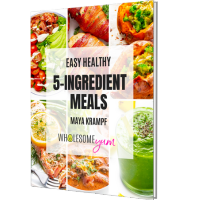
Free: Healthy 5-Ingredient Meals Ebook
Get It Now- Why You’ll Love These Easy Peel Hard Boiled Eggs
- The Best Way To Boil Eggs
- How To Boil Eggs For Easy Peeling
- How Long To Boil Eggs?
- Hard Boiled Eggs Time Chart
- Tips For Easy Peel Hard Boiled Eggs
- Storage Tips
- Hard Boiled Egg Recipes
- My Favorite Tools
- Easy Peel Hard Boiled Eggs (Perfect Yolks!) Recipe card
- Recipe Reviews
Since eggs are my favorite food ever, boiled eggs were one of the first foods I learned to make as a kid. But, I refined my favorite method for these easy peel hard boiled eggs only a few years ago. As a scientist at heart, it was really fun for me to do the testing for this “recipe”. I went through dozens of cartons to get the perfect hard boiled eggs at different doneness levels… and a couple batches of oven baked bacon and air fryer bacon to go with them. 😉
So even if you already know how to boil eggs — and I know many of you do — I hope you’ll learn something new. Because if you want easy to peel boiled eggs, the method does make a difference, and every minute counts for the end result. I have a time chart to make this easy!
Why You’ll Love These Easy Peel Hard Boiled Eggs
- Perfectly cooked to your liking (see the time chart below!)
- Works for soft boiled or hard boiled eggs
- Quick and easy — it’s the fastest stovetop method!
- No specialty ingredients or special equipment needed
- Makes perfect easy peel hard boiled eggs every time
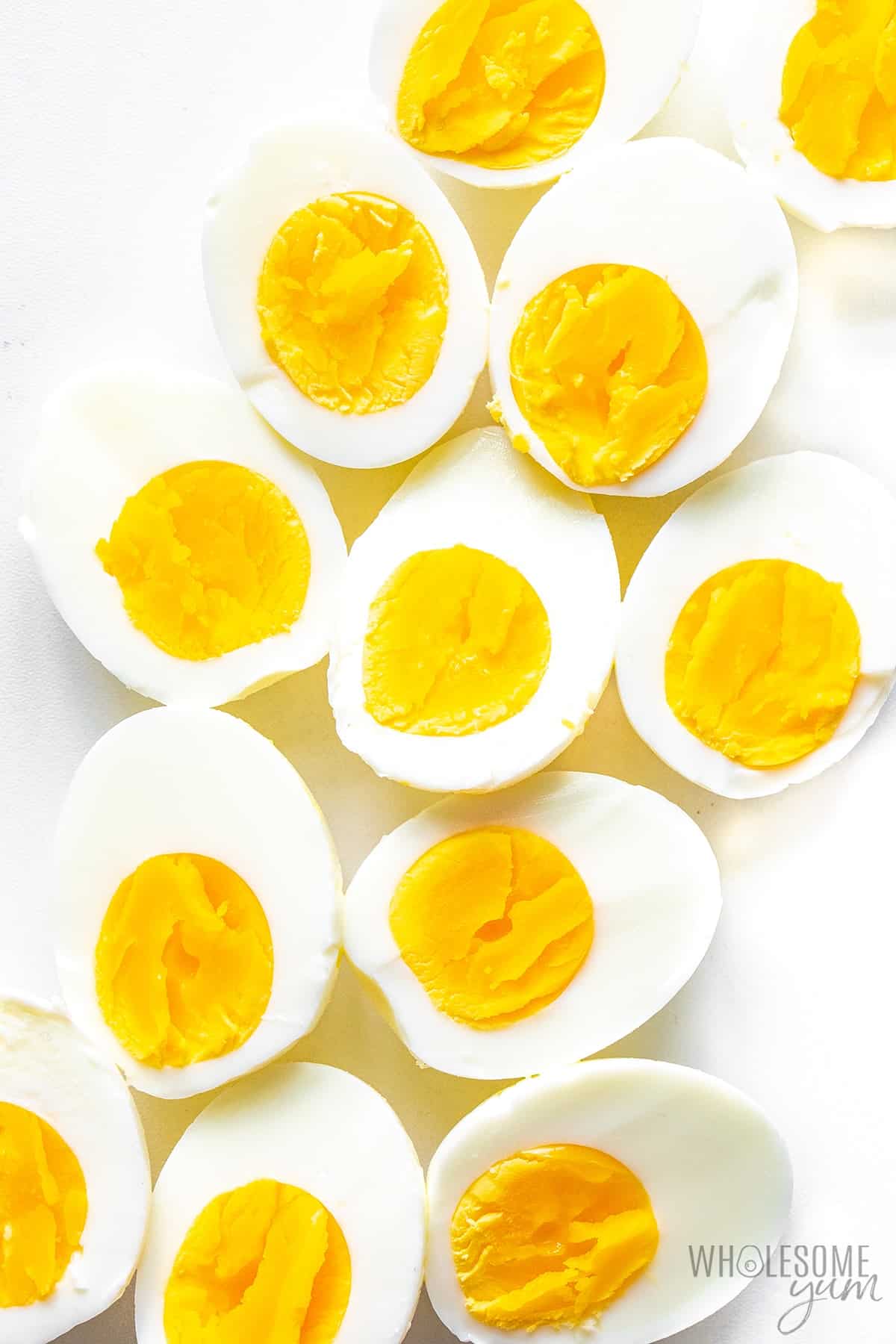
The Best Way To Boil Eggs
There are two main ways to make perfect hard boiled eggs on the stove:
- Most common method – Bring the water with the eggs, then turn off the heat, close the lid, and let them cook in the residual heat. This method works fine, but it takes longer, because the water stops boiling. I’m not a patient person, so I prefer the second way.
- The best method – Once the water comes to a boil, you set a timer and cook them for exactly the number of minutes needed for the level of doneness you want. The key difference is you boil them the whole time, so they are done more quickly. Yay for having faster, perfect boiled eggs!
There are actually lots of other ways to boil eggs. People do it in a pressure cooker, slow cooker, or even air fryer boiled eggs and oven boiled eggs. Still, my go-to way to make easy peel hard boiled eggs is the stove. It’s super easy, no fuss or equipment required, and fast.
How To Boil Eggs For Easy Peeling
This section shows how to make perfect easy peel hard boiled eggs, with step-by-step photos and details about the technique, to help you visualize it. For full instructions, including amounts and temperatures, see the recipe card below.
- Submerge eggs in water. Place your eggs in the bottom of a large saucepan. Add enough water to cover the eggs with at least an inch of water above them.
TIP: Add the eggs before adding the water.
This will ensure they don’t break.
- Add salt and vinegar. Stir gently, being careful not to disturb the eggs too much.
- Boil eggs. Place the pan on the stove over high heat and bring the pot of water to a rolling boil. Then, set a timer and use the boiled eggs time chart below to get the eggs done to your liking.
- Plunge in cold water or an ice bath. Right before the timer is about to go off, turn on the faucet to the coldest that it goes and let it run until the water is ice cold. Once the timer goes off, drain the hot water and place the pan under the cold running water, letting the ice cold water fill the pan. The water will turn lukewarm from the heat of the eggs and pan. Keep running the water (it will overflow from the pot), until the water in the pan is ice cold. (Alternatively, you can also just use a slotted spoon to transfer the eggs to a large bowl of ice water, as shown below.) Leave the eggs in the pot for about 10 minutes, until they reach room temperature.
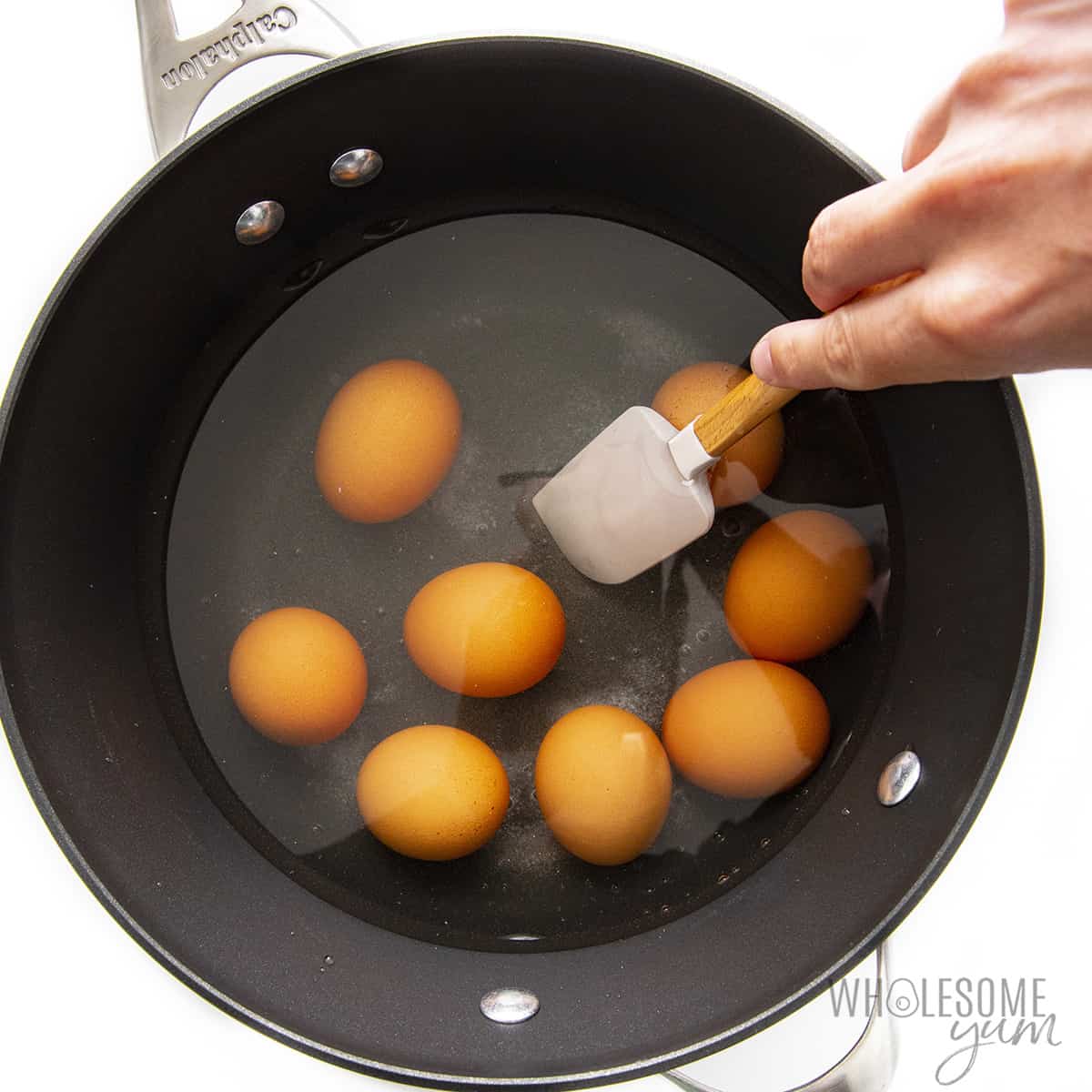
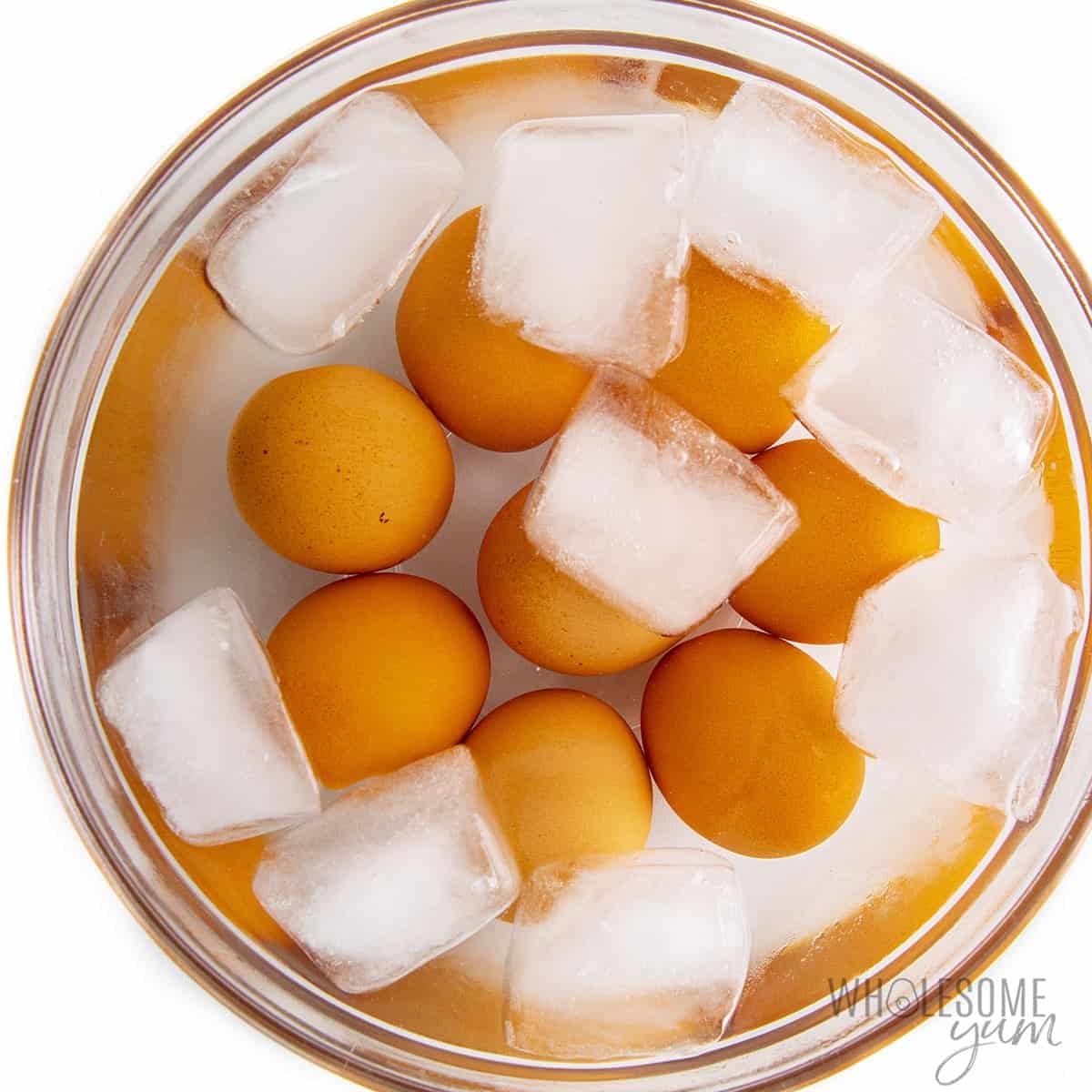
How Long To Boil Eggs?
The time to boil eggs depends on how you want them done. After the water starts boiling, a good estimate is 7-10 minutes for hard boiled eggs and 1-2 minutes for soft boiled eggs, without removing from heat.
Hard Boiled Eggs Time Chart
Now that you know the tricks for easy peel boiled eggs, just follow the cook times in this boiled egg time chart to get the doneness you want:
| Boiling Time | Result |
|---|---|
| 1 minute | Very runny soft boiled eggs |
| 2 minutes | Runny soft boiled eggs |
| 3 minutes | Very gooey medium boiled eggs |
| 4 minutes | Gooey medium boiled eggs |
| 5 minutes | Just set medium boiled eggs |
| 6 minutes | Medium-hard boiled eggs |
| 7 minutes | Very creamy hard boiled eggs |
| 8 minutes | Creamy hard boiled eggs |
| 9 minutes | Firm hard boiled eggs |
| 10 minutes | Very firm hard boiled eggs |
A few important notes about this:
- The times above are how long to boil eggs after the water has reached a rolling boil, and you place the eggs in cold water before bringing it to a boil. If you use some other method, such as adding the eggs to the water after it’s already boiling (don’t recommend), or removing from heat once the water boils, they will take longer.
- My time chart is based on large eggs. It will take a little longer to get to the same level of doneness with extra large or jumbo eggs, or quicker if you have medium eggs.
- Plunging eggs into cold or ice water after boiling is crucial. If you skip this step, your eggs will be overcooked, even if you follow the times above.
Here is a visual showing how my easy peel boiled eggs looked after 1 minute, all the way to 10 minutes:
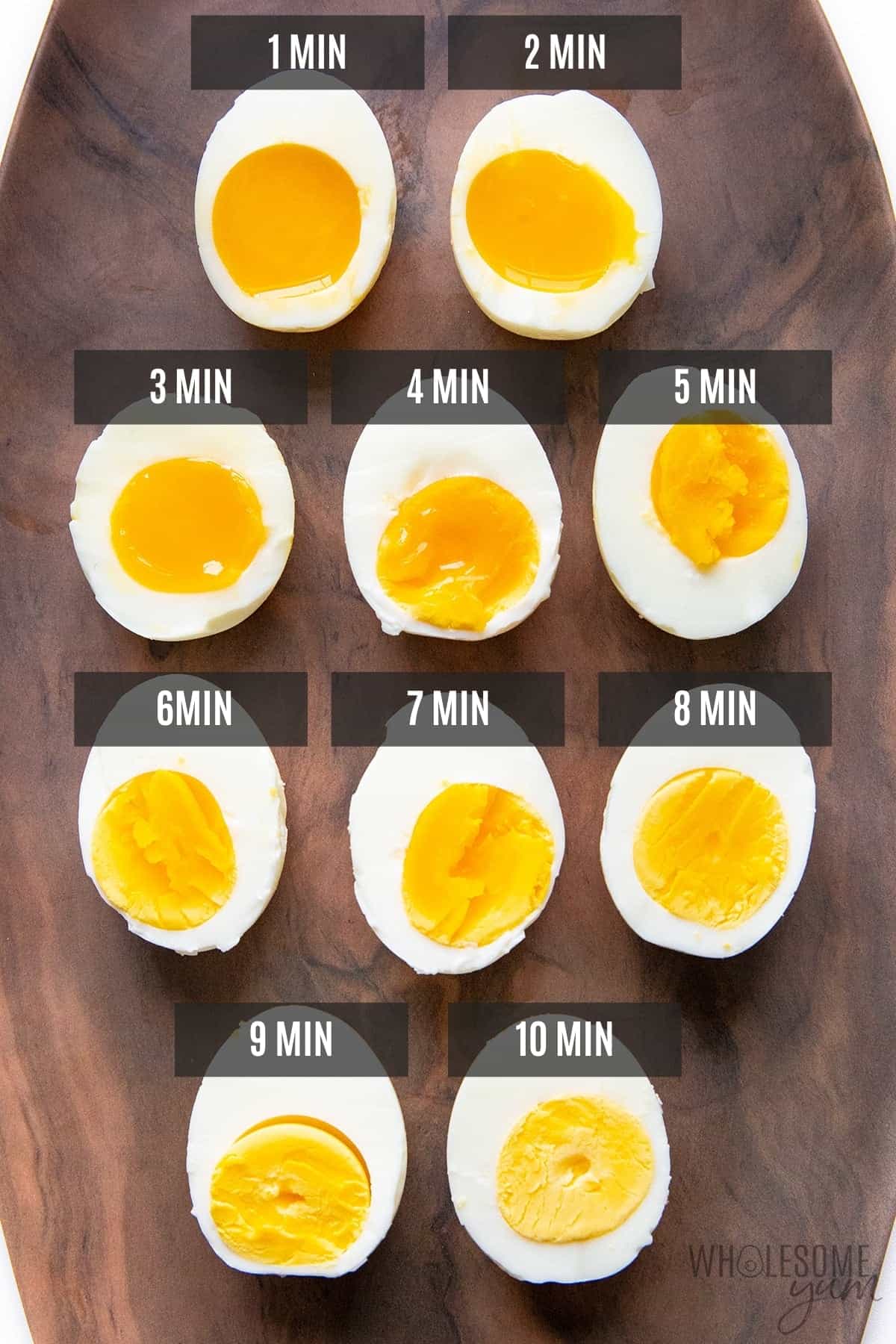
Tips For Easy Peel Hard Boiled Eggs
Before I figured out how to peel hard boiled eggs, the process drove me crazy. Fortunately, after some testing, I found a sure, foolproof method. Here is how to make hard boiled eggs easy to peel every time:
- Use eggs that are a few days old. Fresh eggs are slightly less acidic, so the white sticks to the inner shell more. With older eggs, the shell absorbs more air, becomes more acidic, and also shrinks slightly. All of these aspects create more space between the shell membrane (that covers the egg white) and the shell itself. That means easy peel hard boiled eggs!
- Start with cold water. This is sometimes called “cold start” and helps ensure that the boiled eggs are easy to peel. In contrast, using warm or hot water is called “hot start” and will increase the chances that the shell will stick to the membrane.
- Add salt and vinegar to the water. Salting the water accomplishes a few things: It increases the temperature of the boiling water (so the egg white cooks a little faster and the yolk doesn’t overcook); it helps seal any small cracks or leaks; and a tiny bit permeates the egg shell, which makes for easy peel eggs. The vinegar helps with peeling as well, because it softens the shell. White vinegar or apple cider vinegar both work. Some people swear that adding baking soda helps to make eggs easier to peel. I tried it, but it didn’t make any difference. The salt and vinegar did.
- Plunge the eggs in ice water. This stops the cooking process from residual heat, so you don’t end up with overcooked eggs. Also, some of the water permeates the shell, which helps loosen the bond to the egg white and makes the boiled eggs easy to peel.
- Roll the egg on the counter. I’ve tried different techniques for peeling boiled eggs, and this one wins compared to starting at one end. Simply roll the egg on the counter with the palm of your hand, creating cracks all over the widest part. Then, start peeling at one of the cracks toward the center of the egg, and the shell will come off from there.
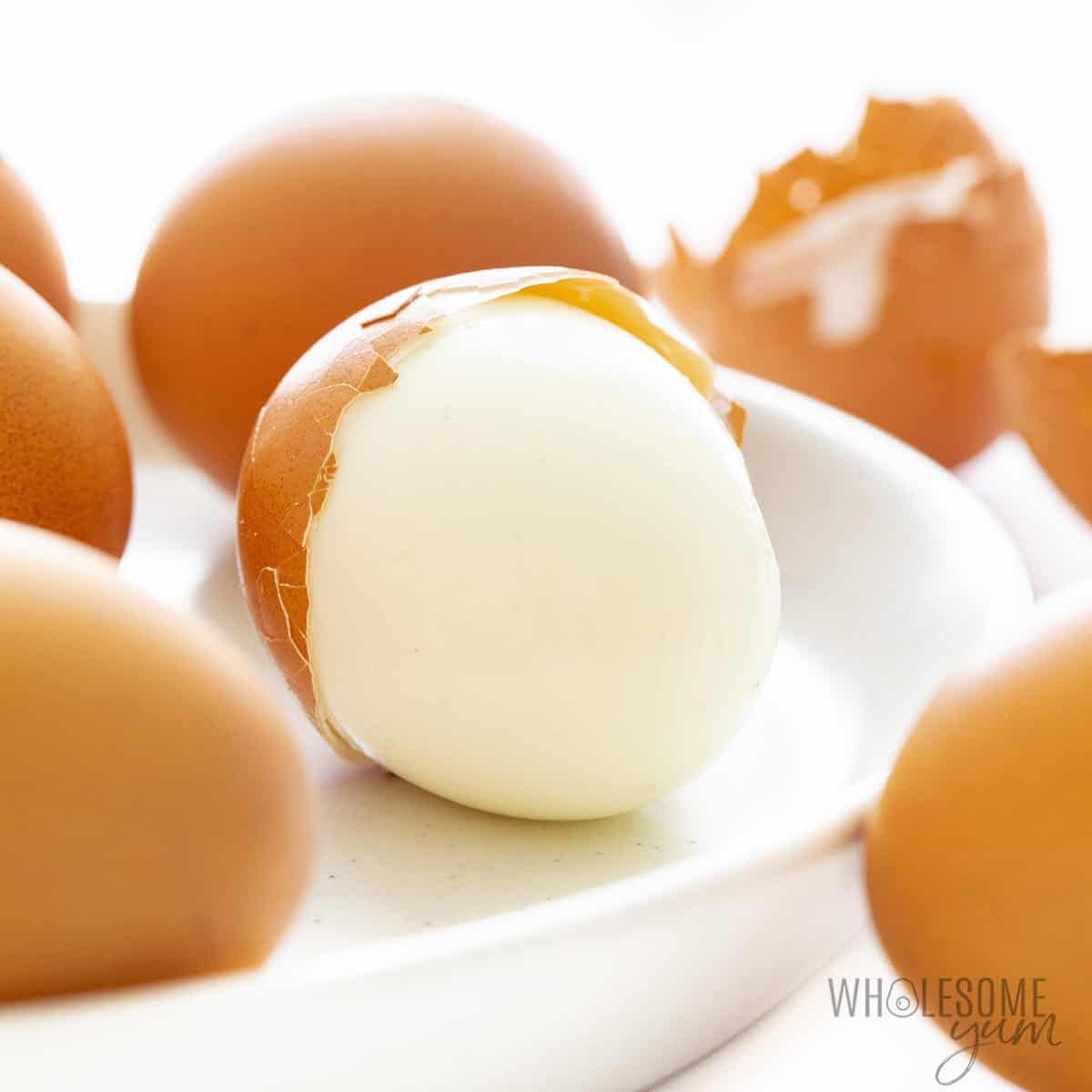
Storage Tips
- When to peel: The soonest time to easily peel eggs is after they have sat in cold or ice water for 10 minutes. If you won’t eat them right away, it’s best not to peel them, because they will last longer with the shell than without. However, if you still prefer to peel your eggs all at once, you can.
- Storage: Hard boiled eggs are okay at room temperature for a couple hours, but beyond that, store them in the refrigerator (unpeeled if possible). Boiled eggs in the shell will keep in the fridge for up to 1 week. Without the shell (store submerged in water or draped with a wet paper towel and change daily), they will last for up to 5 days.
- Reheating: You can reheat boiled eggs, but don’t use the microwave or they will explode. Instead, place the egg(s) into a glass bowl and add boiling water to submerge. Let the eggs sit in the hot water for about 10 minutes, then remove and enjoy!
- Freezing: Don’t do it — it ruins the texture of the egg white! If you really want to, you can freeze just the yolks for up to 3 months.
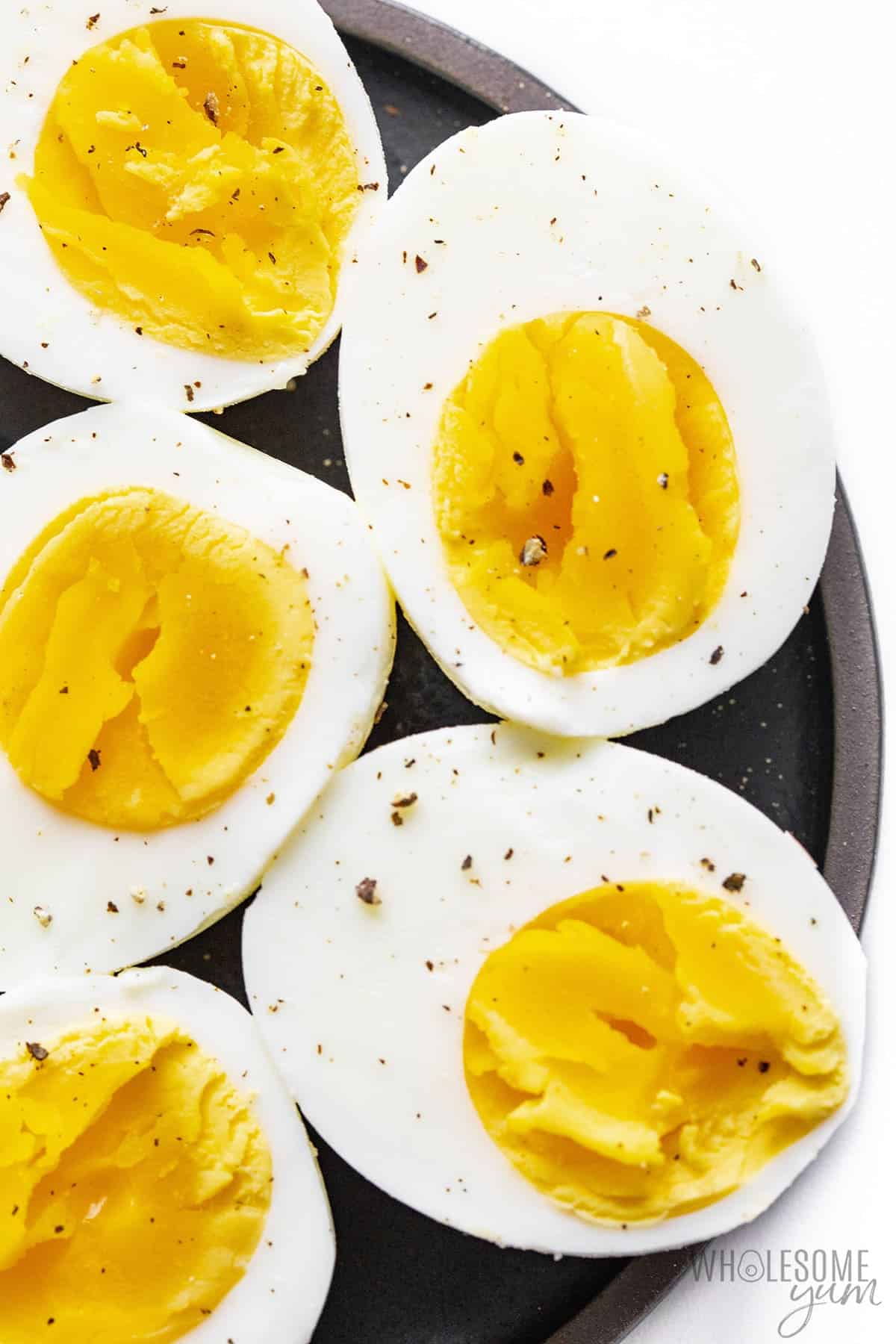
Hard Boiled Egg Recipes
Now that you know how to boil eggs perfectly (and peel them easily) every time, I hope you’ll make them more often! Here are some of my favorite ways to enjoy them:
- Salt & Pepper – When you have that blissful creamy yolk, that’s all you need to enjoy perfect boiled eggs.
- Deviled Eggs – My fave is simple deviled eggs with bacon or basic deviled eggs, but they are also delicious with salmon lox on top or avocado mashed in.
- Egg Salad – Either a classic egg salad or avocado egg salad, or mix with proteins, such as tuna salad with egg or ham salad. These types of salads use a lot of eggs, so you’ll definitely want to use this method for easy peel hard boiled eggs!
- Other Salads – Boiled eggs work well in cauliflower potato salad (a healthier alternative to potato salad) or seven-layer salad. For meal salad options, try a cobb salad or chef salad.
- Soft Boiled Egg Soldiers – Dunk cheese sticks or veggies into a soft boiled egg. (You can also do this with oven baked eggs!)
- Breakfast Sandwich – Layer sliced hard boiled eggs, cheese, and bacon on your favorite bagel. I often use low carb bagels, but any kind you like will do.
My Favorite Tools
- Saucepan – This one heats evenly and is a great universal size for boiling eggs.
- Apple Cider Vinegar – This kitchen staple is useful for so many recipes, and will make for easy to peel hard boiled eggs.
- Sea Salt – Not all salt is created equal! This one is easy to pinch and full of naturally occuring minerals. It’s also a must for both cooking and eating your boiled eggs.
Easy Peel Hard Boiled Eggs (Perfect Yolks!)
Learn how to boil eggs perfectly, with time chart for perfect yolks! Get easy peel hard boiled eggs every time using this fast simple method.
Instructions
Tap on the times in the instructions below to start a kitchen timer while you cook.
How To Boil Eggs Perfectly:
-
Place eggs in a single layer at the bottom of a large saucepan or pot. Add enough water to cover the eggs with at least 1 in (2.5 cm) of water over them.
-
Add a tablespoon (15 mL) of vinegar and a tablespoon (14 g) of sea salt to the pot. Stir gently.
-
Place the pan onto the stove over high heat. Bring the water to a rolling boil.
-
Once the water is boiling, set a timer to the following number of minutes based on how you want your eggs.
1 minute – Very runny soft boiled eggs
2 minutes – Runny soft boiled eggs
3 minutes – Very gooey medium boiled eggs
4 minutes – Gooey medium boiled eggs
5 minutes – Just set medium boiled eggs
6 minutes – Medium-hard boiled eggs
7 minutes – Very creamy hard boiled eggs
8 minutes – Creamy hard boiled eggs
9 minutes – Firm hard boiled eggs
10 minutes – Very firm hard boiled eggs
-
Right before the timer is about to go off, turn on the faucet to the coldest that it goes and let it run until the water is ice cold. Once the timer goes off, drain the hot water and place the pan under the cold running water, letting the ice cold water fill the pan. The water will turn lukewarm from the heat of the eggs and pan. Keep running the water (it will overflow from the pot), until the water in the pan is ice cold. Leave the eggs in the pot for about 10 minutes, until they reach room temperature.
How To Peel Boiled Eggs Easily:
-
Once the eggs are at room temperature (but not colder), you can peel them.
-
To peel an egg, roll it on the counter with the palm of your hand, pressing gently to make cracks all over the shell. The peel will come right off!
-
If not using right away, see notes in the post above about how to store hard boiled eggs and when to peel them.
Did You Like It?
Leave a rating to help other readers, or get the recipe sent to your inbox.
Recipe Notes
Serving size: 1 egg
Nutrition facts are provided as a courtesy. Have questions about calculations or why you got a different result? Please see our nutrition policy.
© Copyright Maya Krampf for Wholesome Yum. Please DO NOT SCREENSHOT OR COPY/PASTE recipes to social media or websites. We’d LOVE for you to share a link with photo instead. 🙂
How To Boil Eggs Perfectly (Easy Peel)
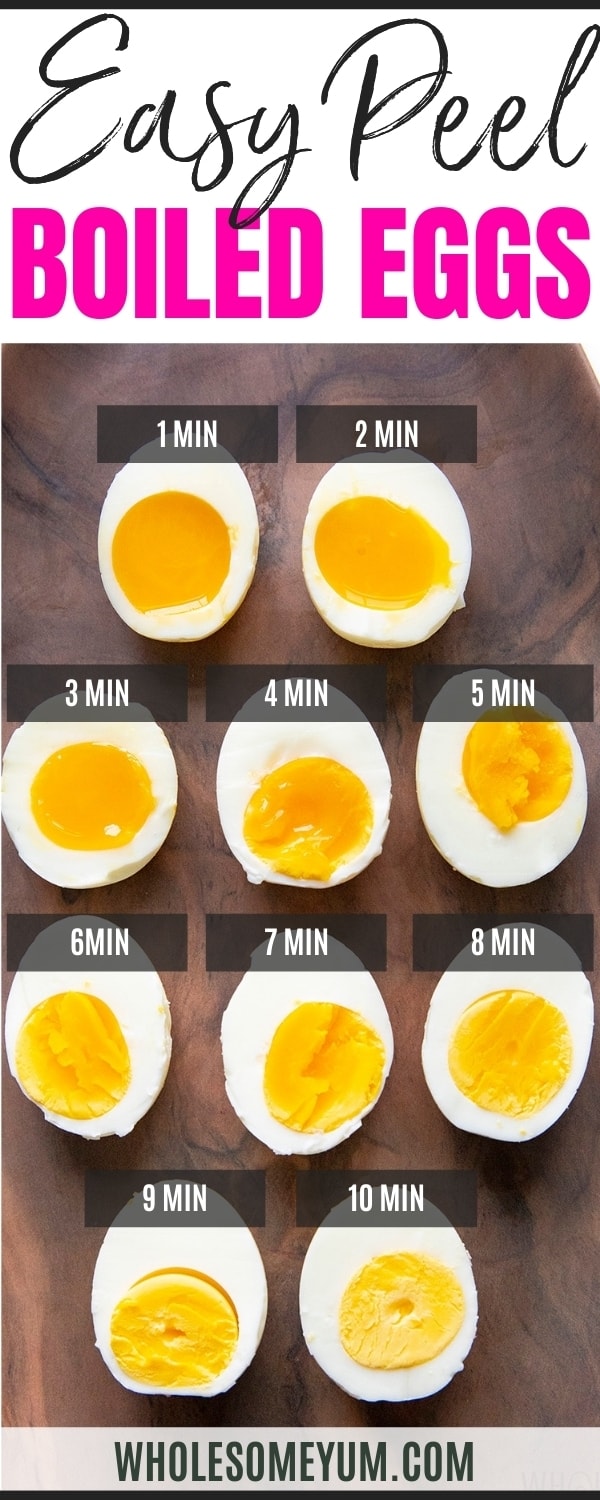
 My
My Shop
Shop Wholesome Yum
Wholesome Yum
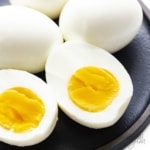

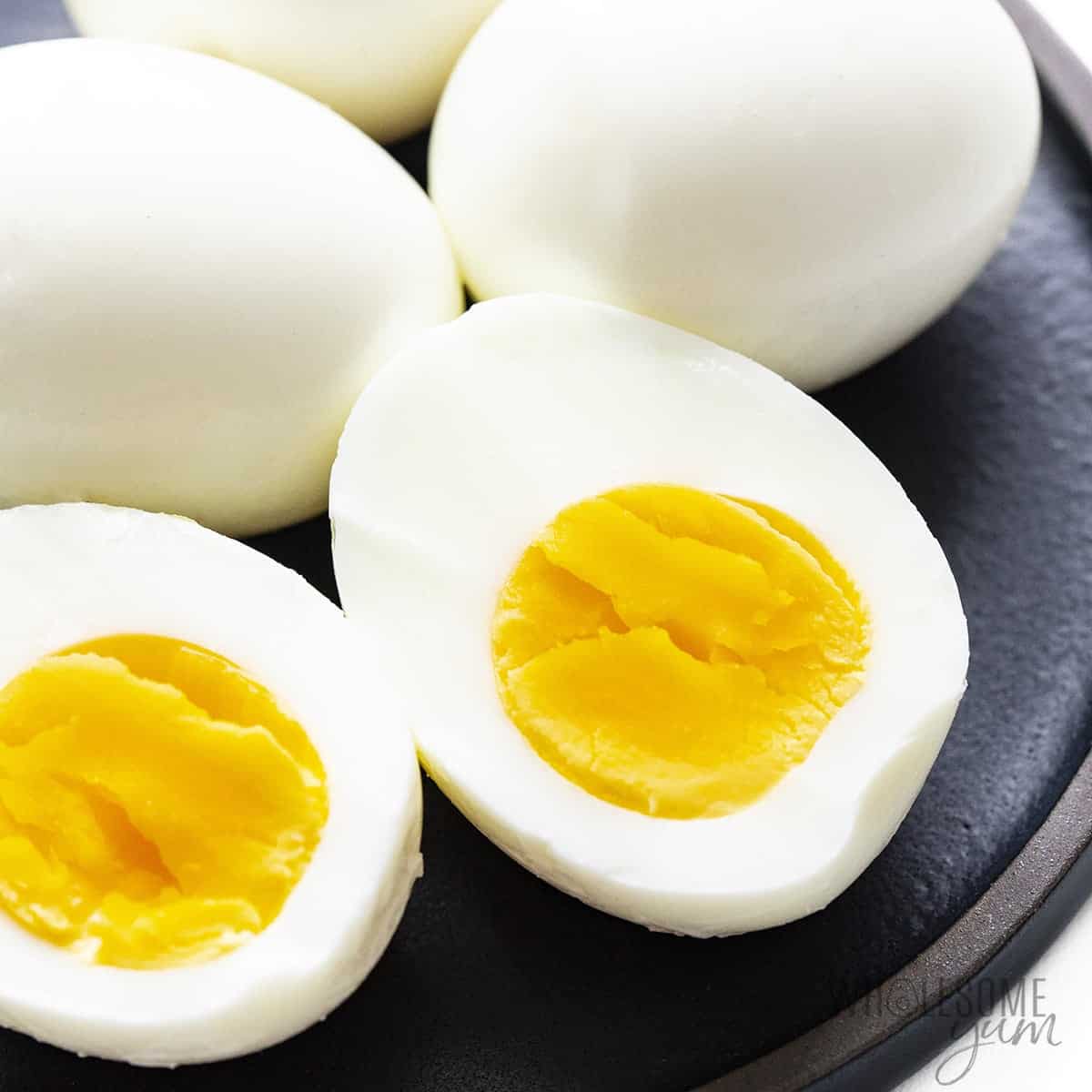
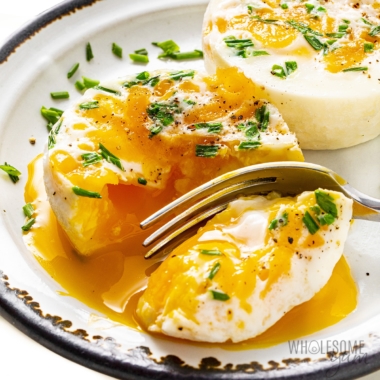
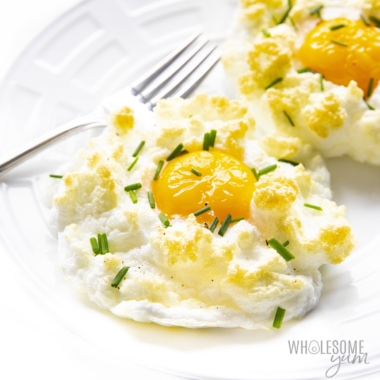
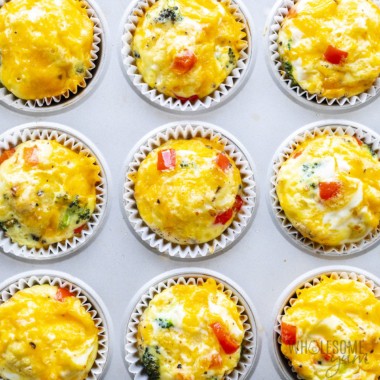
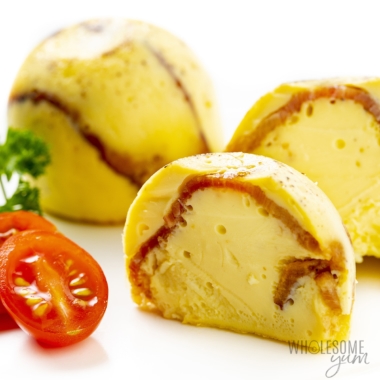

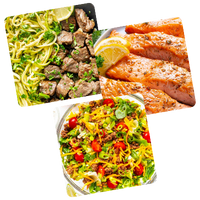




297 Comments
Caroline
0After years of struggling to be able to do this… I have perfectly hard boiled egg which peel very easily. Thank you!
Ashley
0This is terrible! I tried boiling for 1 minute- complete raw wasted 2 eggs. I tried boiling for 2 minutes- completely raw wasted 2 more eggs! These times are NOT accurate!
Wholesome Yum M
0Hi Ashley, Did you add the eggs to cold water and start timing after the water reached a full boil? They should not have been raw.
Ashlee
0I don’t think you followed the directions or understood them. Plus eggplant be “completely raw” when they’ve been cooked. You have to boil the water and once it is boiling THEN you start your timer.
Patricia Grace
0This article was VERY helpful. I was so annoyed with peeling eggs. Adding salt and vinegar, putting them in ice water, and then rolling the egg all resulted in an easy to peel, beautiful boiled egg! I didn’t measure anything, as I started before I realized you had complete instructions.
All I had was balsamic, so my eggs came out with colored shells lol Doesn’t matter though, can’t taste the vinegar. They’re great!
Charlotte
0Hi, I read through this article and many comments below. What I was hoping to learn but couldn’t find was how much salt and vinegar to add. I assume it depends on the number of eggs being boiled but is there a general rule of thumb? Thank you.
Wholesome Yum M
0Hi Charlotte, 1 tablespoon of each salt and vinegar for 8 eggs.
John sosa
0I don’t care how you boil eggs, I remember when I was a kid & teenager, (I’m 61 now) but back then I NEVER had problems peeling boiled eggs! It’s what they are feeding chickens now days that makes the peeling so difficult. I think they feed them stuff that makes the shell harder so they don’t break as easy. Therefore it makes a boiled egg harder to peel. Check into it.
Carol Carpenter
0I always steam cook my hard boiled eggs. Start with cold eggs and heat up my steamer saucepan. Cover and cook 17 minutes. No salt, no vinegar and they come out perfect and easy to peel every time. I use a small jar and a little water to shake my egg around before peeling. Works great!
jj
0These peeled beautifully, even very fresh eggs bought that day. I’ve known the frustration of picking tiny bits of shell and membrane leaving ugly lumpy-looking eggs. This method worked great.
Sue
0I only have balsamic vinegar on hand and need to boil my eggs tonight. Will this work or will it make the eggs taste weird? Thanks for any advice you can give!
Wholesome Yum M
0Hi Sue, I don’t believe the balsamic will affect the flavor of your eggs, but it may stain them a dark brown!
Kristal
0I tried this for the first time for Thanksgiving eggs because I wanted them to be pretty. I gently let the eggs into the hot water with a small strainer. After a few seconds in, all 12 started cracking and I had a pot of egg noodlish water. It was horrible.
Maya | Wholesome Yum
0Hi Kristal, The recipe says to boil the water with the eggs already in it, not let the eggs into the hot water. That is likely why you had issues.
Mary
0This is great info. We eat a lot of eggs and found each stove heats the water at a different rate depending on the burner. We have used 3 different stoves in the past year. Some burners take longer to bring to a boil then others. Our new house has faster heating on high. Also the temp coming from the faucet makes a difference. I like your peeling tips because I struggle with nice smooth whites for deviled eggs. Super informative article. Thanks so much!
Gayle Marshall
0Is there a difference in timing using an electric stove or a gas stove (as the former can take much longer to get to boiling)? ie once it’s boiling using slow electric stove, should I then cook less than stated times? Thanks
Wholesome Yum M
0Hi Gayle, There isn’t any need to alter cook times. The temperature of the eggs rise with the water temp, so they shouldn’t cook any faster or slower due to stove top variances.
Joshua Alm
0Wonderful tips on boiling eggs! Was just curious if there is a certain amount of vinegar and salt to add to water?? Also, I’m assuming the eggs were room temp?? Thank you!
Wholesome Yum M
0Hi Joshua, It’s 1 Tablespoon of salt, 1 Tablespoon of vinegar to 4 cups of water. It doesn’t really matter what temperature the eggs are when you do it, because the eggs go in the pan right away and come up to temperature with the water.
Ed
0Your article on boiling eggs was very interesting. You covered the alternatives for boiling in water, but you did not mention using an egg steamer. These devices seem to be efficient and cook eggs in about 10 minutes from start to finish. Just wonder what your thoughts are on egg steamers.
Ed
Wholesome Yum M
0Hi Ed, Egg steamers can work great, but they can also overcook eggs just as quickly as boiling can. Learn your machine well, keep a close eye on your eggs, and it will serve you well.
Liz Bigler
0No mention about the heat…you leave it at high heat for the whole time..? I thought rolling boil cracks the shells….aren’t you supposed to reduce heat? Or no…?
Wholesome Yum M
0Hi Liz, You can keep the pot at the same temp through the cooking process. It should not crack the shells because they were brought up to temperature slowly and not dropped in once the water started to boil.
April
0The one thing that is so often NOT mentioned…and the reason fresh “backyard” eggs will not peel…is because the eggs need to be OLDER. Nearer the expiration date, the easier they will peel. I always keep a couple dozen in the fridge for a couple weeks and use them for the boiled ones. I Never have problems with them.
Millie
0Hi, might be silly but my farm eggs are more difficult to peel more than the ones at the store. Is this true??
Wholesome Yum
0Hi Millie, I haven’t tried this with farm fresh eggs! Let me know if you give it a try.
Laura
0Thanks for all the tips. I have read a lot of articles about eggs and a few said starting the eggs in cold water makes the eggs difficult to peel later. What should the water temperature be when you first place the eggs in the pan (cold, hot, lukewarm)?
Wholesome Yum
0Hi Laura, I start these in cold water.
Kris
0Yikes. I usually boil my eggs for 12 minutes but decided to try 10 for this recipe. The yolks aren’t done enough and rolling the eggs on the counter just squish them into pieces. The egg whites stick to the shells and can barely be peeled off without throwing most of the egg whites away. I’ll never try adding vinegar again and just stick to salt.
Maya | Wholesome Yum
0Hi Kris, Did you let the eggs sit under cold running water for 10 minutes before trying to roll or peel them? This is a crucial step because the eggs continue to cook a little inside as they cool. Otherwise, it’s also possible that your eggs were bigger than mine – the times are based on Large eggs, so if yours are XL or Jumbo, they will take longer.
Carol
0I like to make my boiled eggs in a steamer.
Suzanne Lehavi
0How many minutes for 8 eggs, please
Maya | Wholesome Yum
0Hi Suzanne, The time will not change if you reduce the number of eggs.
Allan Christensen
0How to save water, when boiling eggs:
Steam boil the egg’s by: adding 1 little finger nail height worth of water, put stove on high heat, when water boils, add eggs, put on lid, and turn heat down to medium high. Then steam for the number of minutes you wan’t, and then cool down the eggs in cold water (add ice cubes, to save on running water).
Nicole Dawson
0I make hard boiled eggs for my daughter in batches as well and found that using the salted water method works best. When it comes to peeling, the tricky that works for me is to firmly shake the saucepan back & forth so the cooled eggs start to crack. Kinda like making jiffy popcorn. It cracks the shell and makes it super easy to peel.
Linda
0I loved your piece on hard boiled eggs! And had a question— with your method (ie boiling the egg for the entire cooking time)— do you start the egg After the water (& salt/vinegar) are already boiling? Or do you start the egg in cold water? And if you do the first, ie drop the egg into already boiling water— doesn’t it usually crack due to the temp differences? Thanks!
Maya | Wholesome Yum
0Hi Linda, You put the eggs in the cold water first, then pour the water over them, and then place onto the stove to bring to a boil. Don’t wait for the water to boil before adding the eggs, or they’ll be undercooked (plus they’ll crack like you said).
Krista
0Thank you so much for this recipe!! I have never commented on a blog, but this deserves it!!! I looked at all the eggs and decided the one that looked best to me (because I am the grey overcooker that you mentioned – lol) and followed the recipe. They turned out AHHHHMAZING! Thanks for taking the time to research the perfect hard boiled egg. 🙂
M
0Worked great! Thanks for the tips. Peeling eggs one micron at a time is maddening, this did the trick.
Athena Poe
0Thank you for the tips! Very helpful! What about if you are boiling eggs for Easter eggs that will be colored? We make egg salad and deviled eggs from them when we are done with our tradition. (We color the night before and let the easter bunny see them in the fridge on his nightly visit, then prepare the following day.) It drives me crazy that I can never get them to peel right and half the egg ends up in the trash. If I use the salt and vinegar for easy peel where the vinegar softens the shell, will that affect the coloring of the eggs at all? Sorry if this is a no brainer but I was curious as I was reading since you seem to know a lot about this subject. Thank you again for the helpful tips! I will be following this guideline in hopes of not losing my sanity in the peeling process again
Maya | Wholesome Yum
0Hi Athena, It should be fine to dye the eggs with food coloring after using this method.
Bonnie
0Does it make any difference in easier peeling if brown-shell eggs are used as opposed to white shells? And using the same boiling/cooling/salt/vinegar process?
Maya | Wholesome Yum
0Hi Bonnie, It shouldn’t make any difference in peeling. I’ve heard some anecdotes that some people find brown ones harder to peel, but we always buy brown and they peel just fine.
Melanie
0Thank you so much. Peeling eggs can be a nightmare. Your tips really helped. I needed to make 20 for a family gathering. Last time was a disaster. Much better this time.
Lisa Pankratz
0Thanks for your post. Just wondered if I want to make say 2 dozen boiled eggs at once, would I triple the amount of vinegar and salt? (The recipe was for 8 eggs.). Thanks!
Wholesome Yum L
0Hi Lisa, I haven’t tried boiling that many eggs at once but I think that should work.
Jim
0I used table salt instead of sea salt, didn’t have any on hand. Eggs was runny and hard to peel. I boiled water, vinegar and salt, set eggs in for 10minutes, now boiling for 5 minutes more.
Maya | Wholesome Yum
0Hi Jim, It sounds like you put the eggs in after boiling the water? You put the eggs in first and let the water come to a boil with the eggs in there.
William
0How much vinegar do you add to the water to get good results?
Maya | Wholesome Yum
0Hi William, The amount is on the recipe card above – 1 tablespoon.
Katya
0I followed your timing but sadly was disappointed. After even not full 2 minutes after boiling, the eggs were the 6-7 minute diagram you provide. I added the salt and the apple cider vinegar to the water prior to it boiling. After 1:47 I ran the eggs under cold water for a few seconds before placing them into ice bath. I am left wondering what went wrong….
I love eggs just not the hard yolks. My yolk must be runny for me to eat it.
Maya | Wholesome Yum
0Hi Katya, Sorry to hear you had issues with them. Were your eggs “large” in size, and did you start the timer immediately after boiling? If your eggs are on the smaller side, you would need less time. I tested the times to get the above pictures multiple times to confirm they work with large eggs, but the size will affect the time for sure.
Evita R
0This is a great read and find on Pinterest! I’m making some Asian noodles and was originally looking for the perfect amount of time to cook eggs creamy/medium and this was incredibly informative. I like the science, experimentation and time you put into this and peeling the eggs is the absolute worst part of the process!!! So, I’m going to try the salt and vinegar and say a little prayer and hope that this will change my mind about boiling eggs once and for all! Haha!
Sara
0Do you put the lid on the pot after it reaches a boil?
Maya | Wholesome Yum
0Hi Sara, No, with this method you don’t need to cover them.
Tina M Nichter
0Do you put your eggs in the water first or after it starts boiling?
Maya | Wholesome Yum
0Hi Tina, It would be before. Place the eggs in the pot first, then add water, then bring to a boil.
Fergie
0Thank you for your posting on boiling eggs. I usually boil my eggs 20 min. then immediately place them in ice cold water to shock them and the peeling comes off much easier.
Trent
0Thank you. I like to boil them, cut them in half and sprinkle salt, turmeric and smoked paprika. Yum!
Samme
0Hello! I love reading your recipes! I just wanted to add that when peeling an egg after you roll it on the counter, if you lift the shell a little bit you can stick a teaspoon under there and the shell will easily lift off. It’s a little tricky at first, but if you stick it in and then gently move it around a little bit, the shell will fall away. My grandmother taught me this many years ago.
Maya | Wholesome Yum
0Thank you so much for sharing, Samme! Great tip!
Linnie
0The easiest way I found is pressure cooking, peels so easy.
Maya | Wholesome Yum
0Thanks, Linnie! I have a post about that coming soon.
Kimberly Rodriguez
0I just have a question. Do you start with eggs from the refrigerator or do you bring them to room temperature first?
Maya | Wholesome Yum
0Hi Kimberly, Straight from the fridge is fine! The times would probably be a bit lower if starting from room temp.
Gloria Hardy Moore
0So, scientist-at-heart-to-heart, I’ve been thinking about this for a while. I have a science degree and I have studied physics & chemistry. I have been using xanthum gum for a while now and we all know it absorbs whatever liquid it is put in. If you start with dry xanthum gum and a recipe doesn’t call for much liquid then what will your end result be? I’ve thought about mixing up some xanthum gum at the beginning of a baking cycle would it make the outcome more moist? I’m sure it would but not sure if it would be better.
So what do you think?
Maya | Wholesome Yum
0Hi Gloria, I love these discussions. It depends on the usage. Xanthan gum can have many functions like binder, thickener, and stabilizer, so it really depends on the recipe. In many baking recipes it’s not used with a lot of liquid, so in these cases it acts as a binder.
Barathi
0Thanks a lot! A lot of advice!
Maya | Wholesome Yum
0Thank you for stopping by!
Natalie
0Hi Maya, You are such a truly patient person while you don’t think like that
You did a very great job!! The 10-minute-boiling-egg chart is awesome!!
Who can say boiling eggs is just put the eggs into the hot water after reading this
Maya | Wholesome Yum
0Thank you so much, Natalie! Thanks for stopping by!
Jeanette
0There was a tip I tried, add a level tspoon of baking powder when boiling eggs they peel so easy. I have used this and it works wonders.
Maya | Wholesome Yum
0Great tip, thank you Jeanette!
Heidi
0I’ve always made boiled eggs the way you do, as that was how my mom taught me to make them. Add eggs to water, turn on heat, then start the timer once the water comes to a boil. I’ve always boiled them for 8 minutes before submerging in a cold water bath, however, sometimes they’re slightly undercooked, sometimes they’re perfect, sometimes I get green yolks, so it’s NOT foolproof. I’ve been making boiled eggs for at least 45 years, and there is no consistency to them. And yes, I always use large eggs. All things being equal, boiled eggs are still hit or miss.
Maya | Wholesome Yum
0Hi Heidi, Thank you for the feedback! I’ve always had consistency when using this method, but it’s hard to say what may be causing the discrepancy for you. It might be variances in the temperature of the water at the end?
Crystal
0When I cook 1-3 eggs I do like to boil them. Have you tried cooking 4 or more in the Instant Pot? I have never had all eggs come out of the shell with out a blemish on them. If you haven’t tried the instant pot for eggs, it’s far easier than anything else.
Maya | Wholesome Yum
0Thank you, Crystal! I never had all the eggs come out perfect until I started using the methods in this article. The vinegar, salt, and rolling method on the counter really make them come out perfect for me every time. I’ll have a separate post on the Instant Pot method in the future, too.
Tiffany
0Do you put the eggs in after it’s boiling or put them in the water and bring it up to a boil then start timing? Thanks!
Maya | Wholesome Yum
0Hi Tiffany, Place the eggs into the empty pot first, then cover with water. Add the vinegar and salt as written on the recipe card. Place the pot on the stove and then bring to a boil. The timer starts once the water starts to boil.
Jan Krassner
0Great article. Thank you. Vinegar really does work.
Maya | Wholesome Yum
0Thank you, Jan! Yes, I won’t boil eggs without it.
Roberta
0What about cooking eggs in the microwave? (Without shell to avoid damage for explosion!) So not useful for boiled eggs, although for these you can use a microwave-safe sort of shell, in which you transfer the egg without shell. I have one but I sometimes can’t reach the exact point of creaminess of the yolk.
Maya | Wholesome Yum
0Hi Roberta, I try not to make eggs in the microwave, but when I have to, I like this device which essentially steams them. It works pretty well.
Roberta
0WONDERFUL and very useful resource! Thank you for sharing!
I love eggs too 🙂 I usually boil them (few minutes, I digest them better if the yolk is runny and creamy, but when I prepare them as take away food I have to make them more done to avoid mess).
I also have a kitchen tool that I find really useful and “dummy-proof”: it’s a simple egg cooker I’ve found on Amazon (here in Italy), doesn’t cost much, it’s quite small and very simple to use and clean so you can keep it also in a small kitchen. Try to see if you know what I’m writing about, hope this suggestion may help!
Just a question: white vinegar from corn?! Here is from grapefruit. Anyway, I always substitute it with apple cider vinegar so for me doesn’t matter, just curious about American white vinegar.
Now we wait for your tips about eggs in the SLOW COOKER!
Maya | Wholesome Yum
0Thank you, Roberta! I do have a microwave egg cooker, but don’t usually use it. I prefer boiling them.
White vinegar, or distilled vinegar, usually starts with corn in the United States, but sometimes malt or petroleum. I’ve never heard of it being derived from grapefruit, but that sounds so much better!
I’ll be posting the slow cooker method down the road!
Roberta
0Thank you for your detailed answer, Maya! I didn’t refer to a microwave egg cooker: the one I mentioned I have is to keep as a small kitchen tool.
About white vinegar, sorry for the wrong translation: not grapefruit, but grape fruits, so the fruit to produce wine (in fact here we have from white wine white vinegar and from red wine red vinegar…but never heard vinegar from corn or something else before you explained me, thank you for teaching me :-))
In the microwave, I use silicone molds to cook eggs too, or a simple mug with half a cup of water and a tbs of vinegar to make poached eggs. Put an egg in the mug, covered with a small plate, for 1 minute. The yolk stays creamy and the white comes just done, not gummy.
Maya | Wholesome Yum
0Thank you for clarifying that! I know what you are talking about now.
Oh, yes, we do have red wine vinegar and white wine vinegar here too. But those are still less common than plain distilled vinegar. I would imagine that either red or white wine vinegar would work fine for eggs too, though, since the purpose is the acidity.
Thank you for sharing that trick for microwave poached eggs. I’ll have to try it sometime!
Helen
0This is just wonderful! I don’t like separating eggs (don’t we all?) and have stayed away from white cakes and such because of this. We have no kids to dye with, so I think I’ll try this. I’ve also heard that an older egg is easier to separate than the one you just brought home. Older being a day or so.